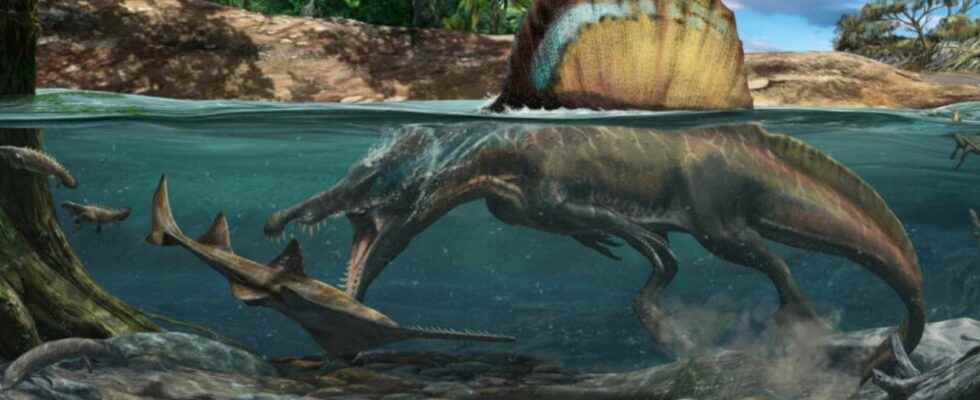You will also be interested
[EN VIDÉO] Interview: three exceptional dinosaurs Dinosaurs are amazing creatures by their nature, their abilities or their size. They know no equivalent in the current animal world. Futura-Sciences interviewed Éric Buffetaut, paleontologist, to tell us about the most surprising dinosaurs.
The dinosaurs were they good swimmers? Adaptation, partial or complete, to life in an aquatic environment has long been considered not to concern non-avian dinosaurs. One of the reasons why these now extinct dinosaurs would have had difficulty conquering aquatic environments would have been theanatomy musculoskeletal of their pelvis, hind limbs and tail. However, the study of the anatomy of Spinosaurus aegyptiacus over the last decade has really launched the hypothesis that a dinosaur could have been subservient to the aquatic environment.
The elements in favor of this hypothesis consisted of short hind limbs, webbed feet and a fin-like tail
The elements in favor of this hypothesis consisted for example of conical teeth, small nostrilsshort hind limbs, webbed feet and a fin-like tail, as well as a diet consisting of fish.
However, if certain elements pointed to a ecology aquatic of S. aegyptiacus, this, as well as that of spinosaurids in general, remained debated. Spinosaurids have been described, following the species and the perpetrators, as predators capable of pursuing their prey in immersion or, on the other hand, as carnivores having a similar hunting mode to that of present-day herons.
A bone structure that does not deceive
In order to determine what the ecologies of various spinosaurids were, researchers analyzed the bone structure of different species fossils of this group as well as those of current species, with very different lifestyles. The study includes ecologies ranging from flight ability to underwater foraging, as well as various organisms including pinnipeds, mosasaursa tyrannosauruspenguins and cormorants.
The authors explain in a article published in Nature that osteosclerosis characterizes many species of amniotes with aquatic ecology such as crocodyliformes and cetaceans. Osteosclerosis is defined by the addition of mass additional bone at the outermost, or cortical, part of a bony element. The internal cavity of the bone element also includes very dense networks of bone tissue, which gives an aquatic animal a higher skeletal density than an individual with a terrestrial lifestyle. This increased density allows the specimen to submerge for hunting or hiding.
The analysis of the bone density from femur and ribs in three spinosaurids reveals diverse ecologies. The significant bone densities of Spinosaurus and of Baryonyx are similar to those of modern crocodyliforms and waterfowl. These data therefore suggest that these two spinosaurids had an underwater hunting mode, unlike Suchomimus whose bone structure was more similar to terrestrial amniotes.
The authors point out that certain spinosaurids are, to date, the only non-avian dinosaurs to be adapted to aquatic life. The authors also explain that the analysis phylogenetic that they carried out shows that the mode of underwater hunting is the ancestral ecology in spinosaurids. They point out, moreover, that if the density of the bones proves that some species were adapted to hunting underwater, this does not mean that the other species were not particularly dependent on aquatic environments. The anatomy of Suchomimus indicates an adaptation to a diet piscivorous and this great predator therefore probably prowled, if not in the streams, on the banks of the rivers.
Support your independent scientific media: discover our subscription formulas!
4 good reasons to subscribe to Futura on Patreon:
- A site without any advertising from 3.29 euros per month.
- It is without commitment.
- Access to priority content, in preview, just for you.
- You support our business in the best possible way. A real motivation for us!
Interested in what you just read?
